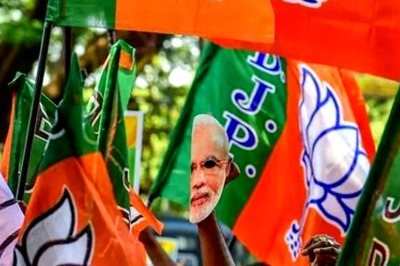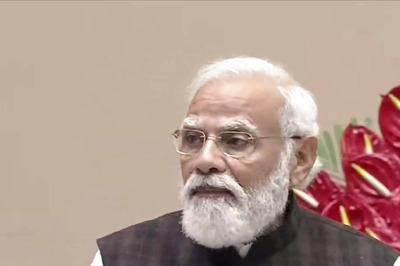
views
1st February the Budget Day is a few blinks away, with hopeful expectations of a pro-reform Education Budget 2022-23. All the stakeholders of education whether it be students, teachers, parents or Edtechs are waiting for the government to lead the path towards better and normal days.
With every new Covid variant challenging science, society and students more, the stop-start arrangement of educational institutes is heavily hurting the learning process of students. These abrupt stops are having a crippling effect on the educational sector as a whole.
Read | What Union Budget 22-23 Can Do for Our Children?
The closure of schools over the past two years have impacted over 250 million students. Not to mention the technological and financial uncertainty burdened upon the parents and teachers.
This Budget, therefore, provides a golden opportunity to reinvent the educational wheel for the 21st century not just in terms of the pro learning curricula, but also on decisive steps on how to achieve the reinvigorating agendas of the New Education Policy, 2020.
In 1964 the Kothari Commission concluded that the educational expenditure needed to be raised from 2.9 per cent of the GDP to 6 per cent. It also recommended that this be achieved in 20 years, that is by the fiscal year, 1985-86. But so far we have managed only marginal improvement. According to the Economic Survey of 2020-21. India’s spending on education as a percentage of GDP was 3-3.5 per cent in the 2019-21 period.
Ironically, the NEP 2020 which also reiterated the same 6 per cent of GDP to the education formula. But the education sector was allotted Rs 93,224 crore for 2021, which was cumulatively 6 and 14 per cent less from the years 2020 and 2019 respectively. So, I ask How long are we going to dream and mimic the same figures on paper?
Read | Union Budget 2022 Should Look Beyond Mainstream Education, Bridge Digital Divide: Experts
Attention to this vital sector that drives the foundation of our country, which has the biggest youth population in the world, is just clearly not sufficient. We can certainly do better.
To reap the demographic dividend in the emerging knowledge economy of future India must prioritize investing in tomorrow’s strategic needs. And implement the pro learning curriculum in NEP 2020 to propel the future workforce to be globally competitive and innovation-ready.
Two-fold the Education Budget
How to reach 6 per cent of GDP target? Invest accordingly. Increasing the Budget two-fold will pump the efforts and capital required towards the execution of NEP 2020.
To make world-class educational infrastructure, to uphold the right to education in this pandemic across the country, to promote skilling beyond the urban-rural divide, to encourage higher education among professionals, to provide scholarships, to transform India into a global knowledge super-power. A two-fold increase in the Education budget of 2022 is the obvious and pragmatic step.
Edtechs the future of Education
To reinvent the foundation of the 21st-century education system. India’s Education sector needs e-learning to be a new way forward in schools and higher education institutes.
Ed-techs are the inevitable future of education, but unlike conventional schools which are exempted from the GST, they continue to pay GST at 18 per cent. Looking at the never decreasing cost of education in the country, the Goods and Service Tax (GST) on educational services should be reduced from 18 per cent to 5 per cent.
This pandemic has changed the conventional learning processes and students are now looking at the other supplementary educational sources, hence, reducing the GST will ease the pressure of the parents and make it affordable to all.
Public-Private partnership, long term tax exemptions and support to ed-tech startups will ensure that the sector blooms. Having a central body to regulate best practices in the EdTech space will be largely beneficial for the consumers too.
Technical Training for Teachers
Digitization is expected to be an effective solution in bridging the literacy gap for our country. But our teachers who are masters of blackboard teaching found online teaching to be ineffective with the same conventional approach.
National Achievement Survey (NAS) 2021 too reported that primary grade kids struggled to make sense of questions to test basic comprehension and numerical skills. Highlighting the flaws of online education without proper training.
Technical and soft skills training should be made mandatory for new teachers. Appropriate capital should be allotted specifically in the budget for the Technical Training of existing teachers. They should be trained to teach and maintain the engagement of the students in online classes.
Girl Education Policy
The education of the girl child unfortunately was most hit during the COVID-19. Due to the closing down of schools, many were forced into domestic work or married off. The NEP 2020 did talk about the gender-inclusive funds for the promotion of girl child education but did not find any mention in the budget of 2021.
The allocation for the National Means-Cum-Merit Scholarship Scheme, for Incentive to Girl Child, fell from Rs. 373 crores to Rs. 1 crore in the past two years 2020-21. This is when before the pandemic nearly 57 per cent of girls in India were forced to leave school in Class X or soon thereafter.
India desperately needs a Girl Child Education Policy from this budget of 2022. We need to incentivize the girls’ education through scholarships, bank transfers, through tax exemptions to parents, so that we can enrol and retain them through elementary to higher education, and decrease the drop-out rate while increasing literacy.
Only a healthy brain can be educated
An effective education system should not only take care about the learning outcomes of the students but also the alarming wellness of students. Considering a large number of kids are suffering from screen addiction, online exam anxiety which has been enhanced manyfold by the pandemic.
Expenditure on mental health for kids undernutrition and wellness schemes are the essential need of the hour. An effective school wellness program with provisions mandatory of one on one counselling of students and parents can make wellness and healthy living an integrated part of education which can reap benefits throughout life.
With the demographic dividend in our favour and technology knocking at our doorstep. The youth of India are aligned to take the country to newer heights. But we need the right investments in their skills and stronger government backing so that things accelerate at a faster pace.
— Written by Prashant Jain, CEO, Oswaal Books
Read all the Latest Education News here




















Comments
0 comment